
Home - Search - Browse - Alphabetic Index: 0- 1- 2- 3- 4- 5- 6- 7- 8- 9
A- B- C- D- E- F- G- H- I- J- K- L- M- N- O- P- Q- R- S- T- U- V- W- X- Y- Z
Enterprise
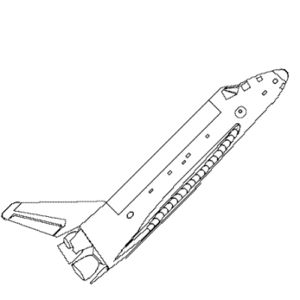 Shuttle Orbiter Shuttle Orbiter side view Credit: © Mark Wade |
AKA: OV-101. Status: Study 1974. Gross mass: 68,027 kg (149,973 lb). Height: 37.24 m (122.17 ft).
Not equipped with a heat shield or subsystems for space flight, it was instead used in the nine-month-long ALT program from February through November 1977 to prove the shuttle's subsonic flight and landing characteristics. Plans to refurbish it as a space-capable orbiter were scrapped, and instead it had a subsequent career as a pathfinder vehicle at launch facilities, a test vehicle for brakes and parachute systems, and a museum piece.
Enterprise, the first Space Shuttle Orbiter, was originally to be named Constitution (in honor of the U.S. Constitution's Bicentennial). However, viewers of the science fiction television series Star Trek started a write-in campaign urging the White House to rename the vehicle to Enterprise. Designated, OV-101, the vehicle was rolled out of Rockwell's Air Force Plant 42, Site 1 Palmdale California assembly facility on Sept. 17, 1976. On Jan. 31, 1977, it was transported 36 miles overland from Rockwell's assembly facility to NASA's Dryden Flight Research Facility at Edwards Air Force Base for the approach and landing test program.
The nine-month-long ALT program was conducted from February through November 1977 at the Dryden Flight Research Facility and demonstrated that the orbiter could fly in the atmosphere and land like an airplane, except without power-gliding flight.
Two NASA astronaut crews-Fred Haise and Gordon Fullerton and Joe Engle and Dick Truly-took turns flying the 150,000-pound spacecraft to free-flight landings.
The ALT program involved ground tests and flight tests. The ground tests included taxi tests of the 747 shuttle carrier aircraft with the Enterprise mated atop it to determine structural loads and responses and assess the mated capability in ground handling and control characteristics up to flight takeoff speed. The taxi tests also validated 747 steering and braking with the orbiter attached. A ground test of orbiter systems followed the unmanned captive tests. All orbiter systems were activated as they would be in atmospheric flight. This was the final preparation for the manned captive flight phase.
Five captive flights of the Enterprise mounted atop the 747 with the Enterprise unmanned and Enterprise's systems inert were conducted to assess the structural integrity and performance handling qualities of the mated craft.
Three manned captive flights that followed the five captive flights included an astronaut crew aboard the orbiter operating its flight control systems while the orbiter remained perched atop the 747. These flights were designed to exercise and evaluate all systems in the flight environment in preparation for the orbiter release (free) flights. They included flutter tests of the mated craft at low and high speed, a separation trajectory test and a dress rehearsal for the first orbiter free flight.
In the five free flights the astronaut crew separated the spacecraft from the 747 and maneuvered to a landing at Edwards Air Force Base. In the first four such flights the landing was on a dry lake bed; in the fifth, the landing was on Edwards' main concrete runway under conditions simulating a return from space. The last two free flights were made without the tail cone, the spacecraft's configuration during an actual landing from Earth orbit. These flights verified the orbiter's pilot-guided approach and landing capability; demonstrated the orbiter's subsonic terminal area energy management autoland approach capability; and verified the orbiter's subsonic airworthiness, integrated system operation and selected subsystems in preparation for the first manned orbital flight. The flights demonstrated the orbiter's ability to approach and land safely with a minimum gross weight and using several center-of-gravity configurations.
For all of the captive flights and the first three free flights, the orbiter was outfitted with a tail cone covering its aft section to reduce aerodynamic drag and turbulence. The final two free flights were without the tail cone, and the three simulated space shuttle main engines and two orbital maneuvering system engines were exposed aerodynamically.
The final phase of the ALT program prepared the spacecraft for four ferry flights. Fluid systems were drained and purged, the tail cone was reinstalled, and elevon locks were installed. The forward attachment strut was replaced to lower the orbiter's cant from 6 to 3 degrees. This reduced drag to the mated vehicles during the ferry flights.
After the ferry flight tests, OV-101 was returned to the NASA hangar at the Dryden Flight Research Facility and modified for vertical ground vibration tests at the Marshall Space Flight Center, Huntsville, Alabama.
On March 13, 1978, the Enterprise was ferried atop the 747 to NASA's Marshall Space Flight Center, where it was mated with the external tank and solid rocket boosters and subjected to a series of vertical ground vibration tests. These tested the mated configuration's critical structural dynamic response modes, which were assessed against analytical math models used to design the various element interfaces.
These were completed in March 1979. On April 10, 1979, the Enterprise was ferried to the Kennedy Space Center. mated with the external tank and solid rocket boosters and transported via the mobile launcher platform to Launch Complex 39-A. At Launch Complex 39-A, the Enterprise served as a practice and launch complex fit-check verification tool representing the flight vehicles.
It was ferried back to NASA's Dryden Flight Research Facility on Aug. 16, 1979, and then returned overland to Rockwell's Palmdale final assembly facility on Oct. 30, 1979. Certain components were refurbished for use on flight vehicles being assembled at Palmdale. The Enterprise was then returned overland to the Dryden Flight Research Facility on Sept. 6, 1981.
During May and June of 1983, Enterprise was ferried to the Paris Air Show, as well as to Germany, Italy, England and Canada, and was returned to the Dryden Flight Research Facility.
In the April-October 1984 time period, Enterprise was ferried to Vandenberg Air Force Base in California and to Mobile, Alabama. From there it was taken by barge to New Orleans, La., for the United States 1984 World's Fair.
In November 1984 it was ferried to Vandenberg Air Force Base and used as a practice and fit-check verification tool for shuttle launch facility SLC-6. On May 24, 1985, Enterprise was ferried from Vandenberg Air Force Base to NASA's Dryden Flight Research Facility.
On Sept. 20, 1985, Enterprise was ferried from Dryden Flight Research Facility to the Kennedy Space Center in Florida. On Nov. 18, 1985, Enterprise was ferried from the Kennedy Space Center to Dulles Airport, Washington, D.C., and became the property of the Smithsonian Institution. The Enterprise was built as a test vehicle and was not equipped for space flight.
During the week of June 8, 1987 Enterprise was used at Dulles Airport to test a prototype Space Shuttle landing arresting barrier, a concept proposed during the Challenger accident investigation.
When NASA was installing the SAREX (Shuttle Amateur Radio EXperiment) amateur radio equipment, none of the flight orbiters were available, so they tested the placement of antennas on a shuttle window using Enterprise.
In 1990, the nose gear was removed for studies that ended up being deferred. In 1996, the nose gear was finally returned to the museum. NASA conducted several inspections on the orbiter, determining it to be in good shape (Assessment team members included; technicians from Dyncorp, the NASA-JSC support contractor which services the NASA aircraft; NASA-JSC structural, materials, and corrosion engineers; a NASA-HQ photographer)
In 1997, the gear was removed again. This time the studies on improved nose gear actually did happen.
In May 2003, the final confirming proof of the cause of the damage to the lost shuttle Columbia's leading edge came from air canon tests developed at Southwest Research Institute in Texas. A wing from the shuttle Enterprise, was equipped with reinforced carbon panels and other heat shield components taken from orbiters that had flown in space. An air cannon shot pieces of foam at the velocities and angles seen in the film of Columbia's launch and punched lethal-sized holes in the heat shield.
Construction Milestones
07/26/72 Contract Award
06/21/79 Start structural assembly of Crew Module
08/26/74 Start structural assembly of aft-fuselage
05/23/75 Wings arrive at Palmdale from Grumman
08/24/75 Start of Final Assembly
03/12/75 Completed Final Assembly
09/17/76 Rollout from Palmdale
01/31/77 Overland transport from Palmdale to Edwards
04/10/79 Delivery to Kennedy Space Center
Taxi Tests:
1. 02/15/77 (Max speed 89 Mph)
2. 02/15/77 (Max speed 140 Mph)
3. 02/15/77 (Max speed 157 Mph)
Crew Size: 2. Habitable Volume: 71.50 m3.
Family: Spaceplane, Suborbital, US Rocketplanes. Country: USA. Launch Vehicles: Space Shuttle. Launch Sites: Edwards, Vandenberg, Cape Canaveral LC39A. Agency: North American. Bibliography: 15, 3191, 3192, 3193, 44, 7, 8, 88.
 | Shuttle Orbiter Shuttle Orbiter 2 view Credit: © Mark Wade |
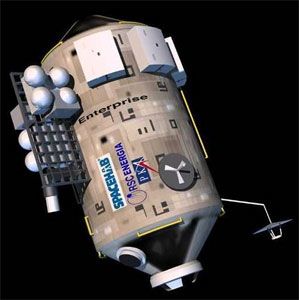 | MPM Credit: Manufacturer Image |
 | Enterprise Orbiter "Enterprise" soars above the NASA 747 carrier Credit: NASA |
 | Enterprise Orbiter "Enterprise" soars above the NASA 747 carrier Credit: NASA |
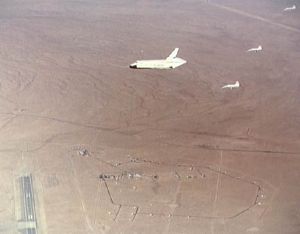 | Enterprise Orbiter "Enterprise" soars above Edwards Air Force Base Credit: NASA |
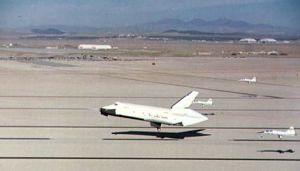 | Enterprise Shuttle Orbiter "Enterprise" lands at Edwards AFB after third ALT Credit: NASA |
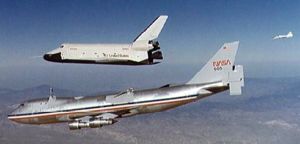 | Enterprise Orbiter "Enterprise" separates from the NASA 747 carrier Credit: NASA |
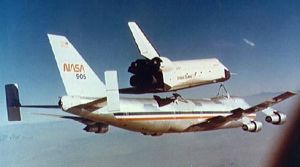 | Enterprise Orbiter "Enterprise" separates from NASA 747 carrier Credit: NASA |
1974 June 4 - . LV Family: Shuttle. Launch Vehicle: Space Shuttle.
- Shuttle Enterprise construction begins. - . Nation: USA. Program: STS. Spacecraft Bus: Shuttle. Spacecraft: Enterprise. Structural assembly of the crew module for shuttle Enterprise (OV-101) begins at Plant 42 in Palmdale..
1974 August 26 - .
- Shuttle Enterprise fuselage assembly starts. - . Nation: USA. Program: STS. Class: Manned. Type: Manned spaceplane. Spacecraft Bus: Shuttle. Spacecraft: Enterprise. Start structural assembly aft fuselage, Enterprise (OV-101).
1975 March 27 - .
- Shuttle Enterprise fuselage complete. - . Nation: USA. Program: STS. Class: Manned. Type: Manned spaceplane. Spacecraft Bus: Shuttle. Spacecraft: Enterprise.
1975 May 23 - .
- Enterprise wings complete. - . Nation: USA. Program: STS. Class: Manned. Type: Manned spaceplane. Spacecraft Bus: Shuttle. Spacecraft: Enterprise. Wings on dock, Palmdale-less elevons, seals and main gear doors-Enterprise (OV-101).
1975 May 27 - .
- Enterprise vertical stabilizer complete. - . Nation: USA. Program: STS. Class: Manned. Type: Manned spaceplane. Spacecraft Bus: Shuttle. Spacecraft: Enterprise. Vertical stabilizer on dock, Palmdale (main fin box only), Enterprise (OV-101).
1975 August 25 - .
- Shuttle Enterprise final assembly. - . Nation: USA. Program: STS. Class: Manned. Type: Manned spaceplane. Spacecraft Bus: Shuttle. Spacecraft: Enterprise. Start final assembly and closeout system installation, Enterprise (OV-101).
1975 September 5 - .
- Enterprise aft fuselage complete. - . Nation: USA. Program: STS. Class: Manned. Type: Manned spaceplane. Spacecraft Bus: Shuttle. Spacecraft: Enterprise. Aft fuselage on dock, Palmdale, Enterprise (OV-101).
1975 October 31 - .
- Enterprise lower fuselage complete. - . Nation: USA. Program: STS. Class: Manned. Type: Manned spaceplane. Spacecraft Bus: Shuttle. Spacecraft: Enterprise. Lower forward fuselage on dock, Palmdale, Enterprise (OV-101).
1975 December 1 - .
- Enterprise upper forward fuselage complete. - . Nation: USA. Program: STS. Class: Manned. Type: Manned spaceplane. Spacecraft Bus: Shuttle. Spacecraft: Enterprise. Upper forward fuselage on dock, Palmdale, Enterprise (OV-101).
1976 January 16 - .
- Crew module on dock, Palmdale, Enterprise (OV-101) - . Nation: USA. Program: STS. Class: Manned. Type: Manned spaceplane. Spacecraft Bus: Shuttle. Spacecraft: Enterprise.
1976 March 3 - .
- Payload bay doors on dock, Palmdale, Enterprise - . Nation: USA. Program: STS. Class: Manned. Type: Manned spaceplane. Spacecraft Bus: Shuttle. Spacecraft: Enterprise. Payload bay doors on dock, Palmdale, Enterprise (OV-101).
1976 March 12 - . LV Family: Shuttle. Launch Vehicle: Space Shuttle.
- Enterprise final assembly complete. - . Nation: USA. Program: STS. Class: Manned. Type: Manned spaceplane. Spacecraft Bus: Shuttle. Spacecraft: Enterprise. Complete final assembly and closeout system installation..
1976 March 15 - .
- Start functional checkout, Enterprise - . Nation: USA. Program: STS. Class: Manned. Type: Manned spaceplane. Spacecraft Bus: Shuttle. Spacecraft: Enterprise. Start functional checkout, Enterprise (OV-101)..
1976 April 22 - .
- Body flap on dock, Palmdale, Enterprise (OV-101) - . Nation: USA. Program: STS. Class: Manned. Type: Manned spaceplane. Spacecraft Bus: Shuttle. Spacecraft: Enterprise.
1976 June 25 - .
- Complete functional checkout, Enterprise (OV-101) - . Nation: USA. Program: STS. Class: Manned. Type: Manned spaceplane. Spacecraft Bus: Shuttle. Spacecraft: Enterprise.
1976 June 28 - .
- Start horizontal ground vibration tests Enterprise - . Nation: USA. Program: STS. Class: Manned. Type: Manned spaceplane. Spacecraft Bus: Shuttle. Spacecraft: Enterprise. Start horizontal ground vibration tests and proof load tests, Enterprise (OV-101).
1976 June 30 - .
- SSME dummy set on dock, Palmdale. - . Nation: USA. Program: STS. Class: Manned. Type: Manned spaceplane. Spacecraft Bus: Shuttle. Spacecraft: Enterprise. SSME dummy set on dock, Palmdale, Enterprise (OV-101).
1976 August 23 - .
- Start Delta F modification, Enterprise (OV-101) - . Nation: USA. Program: STS. Class: Manned. Type: Manned spaceplane. Spacecraft Bus: Shuttle. Spacecraft: Enterprise.
1976 August 27 - .
- Shuttle Enterprise - dummy OMS pods delivered. - . Nation: USA. Program: STS. Class: Manned. Type: Manned spaceplane. Spacecraft Bus: Shuttle. Spacecraft: Enterprise. Reaction control system/orbital maneuvering system pods (simulated), approach and landing tests, on dock, Palmdale, Enterprise.
1976 September 10 - .
- Complete Delta F modifications, Enterprise - . Nation: USA. Program: STS. Class: Manned. Type: Manned spaceplane. Spacecraft Bus: Shuttle. Spacecraft: Enterprise.
1976 September 13 - .
- Start preparations for first rollout, Enterprise - . Nation: USA. Program: STS. Class: Manned. Type: Manned spaceplane. Spacecraft Bus: Shuttle. Spacecraft: Enterprise.
1976 September 20 - .
- Start Delta F retest, Enterprise (OV-101) - . Nation: USA. Program: STS. Class: Manned. Type: Manned spaceplane. Spacecraft Bus: Shuttle. Spacecraft: Enterprise.
1976 October 29 - .
- Complete Delta F retest, Enterprise (OV-101) - . Nation: USA. Program: STS. Class: Manned. Type: Manned spaceplane. Spacecraft Bus: Shuttle. Spacecraft: Enterprise.
1976 November 26 - .
- Complete integrated checkout, Enterprise (OV-101) - . Nation: USA. Program: STS. Class: Manned. Type: Manned spaceplane. Spacecraft Bus: Shuttle. Spacecraft: Enterprise.
1977 January 31 - .
- Mockup SSME's delivered for Enterprise - . Nation: USA. Program: STS. Class: Manned. Type: Manned spaceplane. Spacecraft Bus: Shuttle. Spacecraft: Enterprise. Mass simulated SSMEs on dock, Palmdale, Enterprise (OV-101).
1977 January 31 - . Launch Site: Edwards.
- Enterprise (OV-101) transported to Edwards AFB - . Nation: USA. Program: STS. Class: Manned. Type: Manned spaceplane. Spacecraft Bus: Shuttle. Spacecraft: Enterprise.
1977 January 31 - .
- Mass simulated SSMEs on dock, Palmdale, Enterprise - . Nation: USA. Program: STS. Class: Manned. Type: Manned spaceplane. Spacecraft Bus: Shuttle. Spacecraft: Enterprise.
1977 February 7 - .
- Enterprise (OV-101)/shuttle carrier aircraft mate - . Nation: USA. Program: STS. Class: Manned. Type: Manned spaceplane. Spacecraft Bus: Shuttle. Spacecraft: Enterprise. Enterprise (OV-101)/shuttle carrier aircraft mate start.
1977 February 15 - . Launch Site: Edwards. Launch Complex: Edwards.
- Enterprise (OV-101)/shuttle carrier aircraft mated - . Nation: USA. Program: STS. Class: Manned. Type: Manned spaceplane. Spacecraft Bus: Shuttle. Spacecraft: Enterprise. Complete Enterprise (OV-101)/shuttle carrier aircraft mated.
1977 February 18 - . Launch Site: Edwards. Launch Complex: Edwards. LV Family: Shuttle. Launch Vehicle: Space Shuttle.
- First inert captive flight - . Nation: USA. Program: STS. Class: Manned. Type: Manned spaceplane. Spacecraft Bus: Shuttle. Spacecraft: Enterprise. Conduct first inert captive flight, Edwards (2 hours, 5 minutes), Enterprise (OV-101).
1977 February 22 - . Launch Site: Edwards. Launch Complex: Edwards. LV Family: Shuttle. Launch Vehicle: Space Shuttle.
- Second inert captive flight - . Nation: USA. Program: STS. Class: Manned. Type: Manned spaceplane. Spacecraft Bus: Shuttle. Spacecraft: Enterprise. Conduct second inert captive flight, Edwards (3 hours, 13 minutes), Enterprise (OV-101).
1977 February 25 - . Launch Site: Edwards. Launch Complex: Edwards. LV Family: Shuttle. Launch Vehicle: Space Shuttle.
- Third inert captive flight - . Nation: USA. Program: STS. Class: Manned. Type: Manned spaceplane. Spacecraft Bus: Shuttle. Spacecraft: Enterprise. Conduct third inert captive flight, Edwards (2 hours, 28 minutes), Enterprise (OV-101).
1977 February 28 - . Launch Site: Edwards. Launch Complex: Edwards. LV Family: Shuttle. Launch Vehicle: Space Shuttle.
- Fourth inert captive flight - . Nation: USA. Program: STS. Class: Manned. Type: Manned spaceplane. Spacecraft Bus: Shuttle. Spacecraft: Enterprise. Conduct fourth inert captive flight, Edwards (2 hours, 11 minutes), Enterprise (OV-101).
1977 March 2 - . Launch Site: Edwards. Launch Complex: Edwards. LV Family: Shuttle. Launch Vehicle: Space Shuttle.
- Fifth inert captive flight - . Nation: USA. Program: STS. Class: Manned. Type: Manned spaceplane. Spacecraft Bus: Shuttle. Spacecraft: Enterprise. Conduct fifth inert captive flight, Edwards (1 hour, 39 minutes), Enterprise (OV-101).
1977 June 7 - .
- Complete integrated checkout of Enterprise - . Nation: USA. Program: STS. Class: Manned. Type: Manned spaceplane. Spacecraft Bus: Shuttle. Spacecraft: Enterprise. Complete integrated checkout and hot-fire ground test, Edwards, Enterprise (OV-101).
1977 June 18 - . Launch Site: Edwards. Launch Complex: Edwards. LV Family: Shuttle. Launch Vehicle: Space Shuttle.
- Enterprise flight 1 - . Call Sign: Enterprise. Crew: Fullerton, Haise. Nation: USA. Related Persons: Fullerton, Haise. Program: STS. Class: Manned. Type: Manned spaceplane. Spacecraft Bus: Shuttle. Spacecraft: Enterprise. First manned captive active flight. Enterprise (OV-101)/shuttle carrier aircraft, Edwards (55 minutes, 46 seconds).
1977 June 28 - . Launch Site: Edwards. Launch Complex: Edwards. LV Family: Shuttle. Launch Vehicle: Space Shuttle.
- Enterprise flight 2 - . Call Sign: Enterprise. Crew: Engle, Truly. Nation: USA. Related Persons: Engle, Truly. Program: STS. Class: Manned. Type: Manned spaceplane. Spacecraft Bus: Shuttle. Spacecraft: Enterprise. Second manned captive active flight. Enterprise (OV-101)/shuttle carrier aircraft, Edwards (1 hour, 2 minutes).
1977 July 26 - . Launch Site: Edwards. Launch Complex: Edwards. LV Family: Shuttle. Launch Vehicle: Space Shuttle.
- Enterprise flight 3 - . Call Sign: Enterprise. Crew: Fullerton, Haise. Nation: USA. Related Persons: Fullerton, Haise. Program: STS. Class: Manned. Type: Manned spaceplane. Spacecraft Bus: Shuttle. Spacecraft: Enterprise. Third manned captive active flight. Enterprise (OV-101)/shuttle carrier aircraft, Edwards (59 minutes, 50 seconds).
1977 August 12 - . Launch Site: Edwards. Launch Complex: Edwards. LV Family: Shuttle. Launch Vehicle: Space Shuttle.
- Enterprise flight 4. The space shuttle made its first free flight. - .
Call Sign: Enterprise. Crew: Fullerton,
Haise.
Nation: USA.
Related Persons: Fullerton,
Haise.
Program: STS.
Class: Manned.
Type: Manned spaceplane. Spacecraft Bus: Shuttle.
Spacecraft: Enterprise.
After being carried aloft by a Boeing 747, it was released and made an unassisted landing at Edwards AFB, California. This was part of a series of approach and landing tests carried out at Edwards from February to October. Conduct first free flight, ALT, tail cone on, Edwards (5 minutes, 21 seconds), Enterprise (OV-101), lake bed Runway 17
1977 September 13 - . Launch Site: Edwards. Launch Complex: Edwards. LV Family: Shuttle. Launch Vehicle: Space Shuttle.
- Enterprise flight 5 - . Call Sign: Enterprise. Crew: Engle, Truly. Nation: USA. Related Persons: Engle, Truly. Program: STS. Class: Manned. Type: Manned spaceplane. Spacecraft Bus: Shuttle. Spacecraft: Enterprise. Second free flight, ALT, tail cone on, Edwards (5 minutes, 28 seconds), Enterprise (OV-101), lake bed Runway 17.
1977 September 23 - . Launch Site: Edwards. Launch Complex: Edwards. LV Family: Shuttle. Launch Vehicle: Space Shuttle.
- Enterprise flight 6 - . Call Sign: Enterprise. Crew: Fullerton, Haise. Nation: USA. Related Persons: Fullerton, Haise. Program: STS. Class: Manned. Type: Manned spaceplane. Spacecraft Bus: Shuttle. Spacecraft: Enterprise. Third free flight , ALT, tail cone on, Edwards (5 minutes, 34 seconds), Enterprise (OV-101), lake bed Runway 15.
1977 October 12 - . Launch Site: Edwards. Launch Complex: Edwards. LV Family: Shuttle. Launch Vehicle: Space Shuttle.
- Enterprise flight 7 - . Call Sign: Enterprise. Crew: Engle, Truly. Nation: USA. Related Persons: Engle, Truly. Program: STS. Class: Manned. Type: Manned spaceplane. Spacecraft Bus: Shuttle. Spacecraft: Enterprise. Fourth free flight, ALT, first tail cone off, Edwards (2 minutes, 34 seconds), Enterprise (OV-101), lake bed Runway 17.
1977 October 26 - . Launch Site: Edwards. Launch Complex: Edwards. LV Family: Shuttle. Launch Vehicle: Space Shuttle.
- Enterprise flight 8 - . Call Sign: Enterprise. Crew: Fullerton, Haise. Nation: USA. Related Persons: Fullerton, Haise. Program: STS. Class: Manned. Type: Manned spaceplane. Spacecraft Bus: Shuttle. Spacecraft: Enterprise. Fifth free flight, ALT, final tail cone off, Edwards (2 minutes, 1 second), Enterprise (OV-101), concrete Runway 04.
1977 November 15 - . Launch Site: Edwards. Launch Complex: Edwards. LV Family: Shuttle. Launch Vehicle: Space Shuttle.
- First ferry flight test, Edwards - . Nation: USA. Program: STS. Class: Manned. Type: Manned spaceplane. Spacecraft Bus: Shuttle. Spacecraft: Enterprise. First ferry flight test, Edwards (3 hours, 21 minutes), Enterprise (OV-101).
1977 November 16 - . Launch Site: Edwards. Launch Complex: Edwards. LV Family: Shuttle. Launch Vehicle: Space Shuttle.
- Second ferry flight test, Edwards - . Nation: USA. Program: STS. Class: Manned. Type: Manned spaceplane. Spacecraft Bus: Shuttle. Spacecraft: Enterprise. Second ferry flight test, Edwards (4 hours, 17 minutes), Enterprise (OV-101).
1977 November 17 - . Launch Site: Edwards. Launch Complex: Edwards. LV Family: Shuttle. Launch Vehicle: Space Shuttle.
- Third ferry flight test, Edwards - . Nation: USA. Program: STS. Class: Manned. Type: Manned spaceplane. Spacecraft Bus: Shuttle. Spacecraft: Enterprise. Third ferry flight test, Edwards (4 hours, 13 minutes), Enterprise (OV-101).
1977 November 18 - . Launch Site: Edwards. Launch Complex: Edwards. LV Family: Shuttle. Launch Vehicle: Space Shuttle.
- Fourth ferry flight test, Edwards - . Nation: USA. Program: STS. Class: Manned. Type: Manned spaceplane. Spacecraft Bus: Shuttle. Spacecraft: Enterprise. Fourth ferry flight test, Edwards (3 hours, 37 minutes), Enterprise (OV-101).
1977 December 9 - . Launch Site: Edwards. Launch Complex: Edwards. LV Family: Shuttle. Launch Vehicle: Space Shuttle.
- Complete approach and landing flight tests - . Nation: USA. Program: STS. Class: Manned. Type: Manned spaceplane. Spacecraft Bus: Shuttle. Spacecraft: Enterprise. Complete approach and landing flight tests, including ferry flights, Enterprise (OV-101).
1977 December 12 - .
- Start modification of Enterprise for ground vibe tests - . Nation: USA. Program: STS. Class: Manned. Type: Manned spaceplane. Spacecraft Bus: Shuttle. Spacecraft: Enterprise. Start removal for mated vertical ground vibration test modification at Edwards, Enterprise (OV-101).
1978 March 3 - .
- Complete modification for mated vibe tests. - . Nation: USA. Program: STS. Class: Manned. Type: Manned spaceplane. Spacecraft Bus: Shuttle. Spacecraft: Enterprise. Complete modification for mated vertical ground vibration test, Edwards, Enterprise (OV-101).
1978 March 10 - . Launch Site: Edwards. Launch Complex: Edwards.
- Ferry Enterprise from Edwards to Texas. - . Nation: USA. Program: STS. Class: Manned. Type: Manned spaceplane. Spacecraft Bus: Shuttle. Spacecraft: Enterprise. Ferry Enterprise (OV-101) atop shuttle carrier aircraft from Edwards to Ellington Air Force Base, Texas (approximately 3 hours, 38 min).
1978 March 13 - .
- Ferry Enterprise from Texas to Huntsville - . Nation: USA. Program: STS. Class: Manned. Type: Manned spaceplane. Spacecraft Bus: Shuttle. Spacecraft: Enterprise. Ferry Enterprise (OV-101) atop shuttle carrier aircraft from Ellington AFB to Marshall Space Flight Center, Huntsville, Ala..
1978 May 30 - .
- Start Enterprise (OV-101)/ ET mated vibe test - . Nation: USA. Program: STS. Class: Manned. Type: Manned spaceplane. Spacecraft Bus: Shuttle. Spacecraft: Enterprise. Start Enterprise (OV-101)/ ET mated vertical ground vibration test, MSFC.
1978 July 13 - .
- Reconfigure from boost to launch, vibe test - . Nation: USA. Program: STS. Class: Manned. Type: Manned spaceplane. Spacecraft Bus: Shuttle. Spacecraft: Enterprise. Reconfigure from boost to launch, mated vertical ground vibration test, MSFC, Enterprise (OV-101).
1979 February 26 - .
- Complete mated vertical ground vibe test program - . Nation: USA. Program: STS. Class: Manned. Type: Manned spaceplane. Spacecraft Bus: Shuttle. Spacecraft: Enterprise. Complete mated vertical ground vibration test program at MSFC, Enterprise (OV-101).
1979 April 10 - .
- Ferry flight, MSFC to KSC - . Nation: USA. Program: STS. Class: Manned. Type: Manned spaceplane. Spacecraft Bus: Shuttle. Spacecraft: Enterprise. Ferry flight, shuttle carrier aircraft/Enterprise (OV-101) from MSFC to KSC (1 hour, 52 minutes).
1979 April 18 - .
- Complete left-hand OMS/RCS Phase I qualification - . Nation: USA. Program: STS. Class: Manned. Type: Manned spaceplane. Spacecraft Bus: Shuttle. Spacecraft: Enterprise. Complete left-hand OMS/RCS Phase I qualification, WSTF May 1 Enterprise (OV-101)/ ET/SRBs mated on mobile launcher platform,.
1979 July 23 - . Launch Site: Cape Canaveral. Launch Complex: Cape Canaveral LC39A.
- First test STS stack move from VAB to LC39A - . Nation: USA. Program: STS. Class: Manned. Type: Manned spaceplane. Spacecraft Bus: Shuttle. Spacecraft: Enterprise. Enterprise (OV-101), ET, SRBs transported on mobile launcher platform from Launch Complex 39-A to Vehicle Assembly Building at KSC.
1979 August 10 - .
- Ferry flight, KSC to Atlanta - . Nation: USA. Program: STS. Class: Manned. Type: Manned spaceplane. Spacecraft Bus: Shuttle. Spacecraft: Enterprise. Ferry flight, shuttle carrier aircraft/Enterprise (OV-101), KSC to Atlanta (1 hour, 55 minutes).
1979 August 11 - .
- Ferry flight, Atlanta to St. Louis - . Nation: USA. Program: STS. Class: Manned. Type: Manned spaceplane. Spacecraft Bus: Shuttle. Spacecraft: Enterprise. Ferry flight, shuttle carrier aircraft/Enterprise (OV-101), Atlanta to St. Louis (1 hour, 50 minutes).
1979 August 12 - .
- Ferry flight, St. Louis to Tulsa - . Nation: USA. Program: STS. Class: Manned. Type: Manned spaceplane. Spacecraft Bus: Shuttle. Spacecraft: Enterprise. Ferry flight, shuttle carrier aircraft/Enterprise (OV-101), St. Louis to Tulsa (1 hour, 35 minutes).
1979 August 13 - .
- Ferry flight, Tulsa to Denver - . Nation: USA. Program: STS. Class: Manned. Type: Manned spaceplane. Spacecraft Bus: Shuttle. Spacecraft: Enterprise. Ferry flight, shuttle carrier aircraft/Enterprise (OV-101), Tulsa to Denver (2 hours).
1979 August 14 - .
- Ferry flight, Denver to Hill AFB, Ogden, Utah - . Nation: USA. Program: STS. Class: Manned. Type: Manned spaceplane. Spacecraft Bus: Shuttle. Spacecraft: Enterprise. Ferry flight, shuttle carrier aircraft/Enterprise (OV-101), Denver to Hill AFB, Ogden, Utah (1 hour, 30 minutes).
1979 August 15 - . Launch Site: Vandenberg. Launch Complex: Vandenberg.
- Ferry flight, Ogden to Vandenberg AFB - . Nation: USA. Program: STS. Class: Manned. Type: Manned spaceplane. Spacecraft Bus: Shuttle. Spacecraft: Enterprise. Ferry flight, shuttle carrier aircraft/Enterprise (OV-101), Ogden to Vandenberg AFB (2 hours, 20 minutes).
1979 August 16 - . Launch Site: Edwards. Launch Complex: Edwards.
- Ferry flight, Vandenberg AFB to Edwards - . Nation: USA. Program: STS. Class: Manned. Type: Manned spaceplane. Spacecraft Bus: Shuttle. Spacecraft: Enterprise. Ferry flight, shuttle carrier aircraft/Enterprise (OV-101), Vandenberg AFB to Edwards (1 hour, 10 minutes).
1979 August 23 - . Launch Site: Edwards. Launch Complex: Edwards.
- Enterprise / shuttle carrier demate, Edwards - . Nation: USA. Program: STS. Class: Manned. Type: Manned spaceplane. Spacecraft Bus: Shuttle. Spacecraft: Enterprise. Enterprise (OV-101)/ shuttle carrier demate, Edwards.
1984 November 16 - . Launch Site: Vandenberg. Launch Complex: Vandenberg.
- The Space Shuttle orbiter Enterprise arrives - . Nation: USA. Program: STS. Class: Manned. Type: Manned spaceplane. Spacecraft Bus: Shuttle. Spacecraft: Enterprise. The Space Shuttle orbiter Enterprise arrived at Vandenberg AFB for a series of facility verification tests..
Back to top of page
Home - Search - Browse - Alphabetic Index: 0- 1- 2- 3- 4- 5- 6- 7- 8- 9
A- B- C- D- E- F- G- H- I- J- K- L- M- N- O- P- Q- R- S- T- U- V- W- X- Y- Z
© 1997-2019 Mark Wade - Contact
© / Conditions for Use